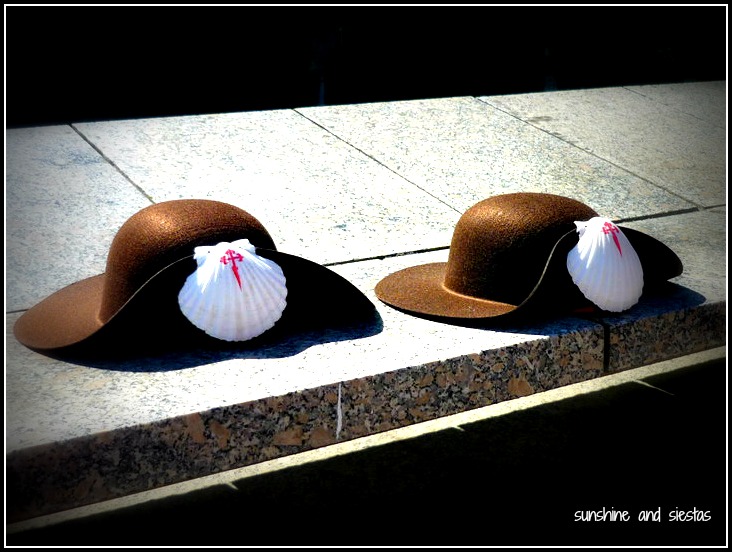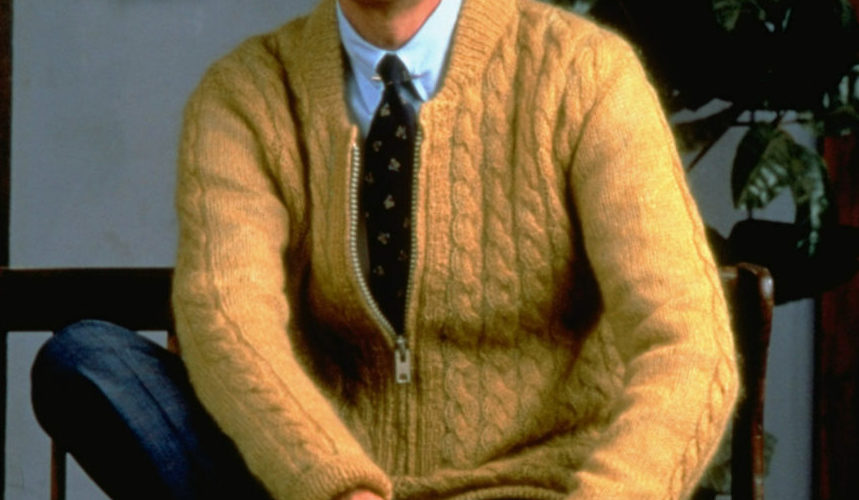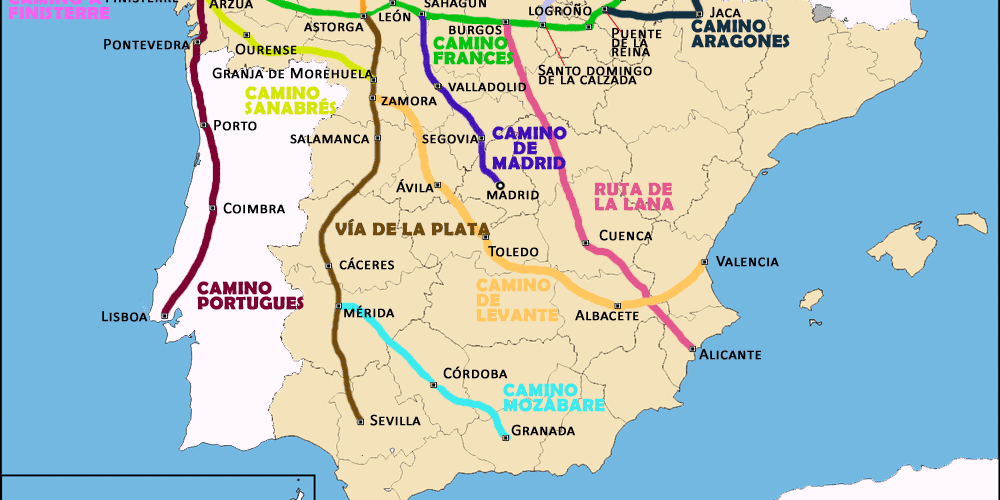Historic El Camino de Santiago, The Way of St James
Last year, my cousin decided to follow a hiking pilgrimage. Her trek was the first time I learned of the El Camino de Santiago. Historically, it is a pilgrimage that normally takes a couple hundred days to complete, depending on which of the multiple paths you take and how fast you walk.
The paths wind through multiple countries and all end at the shrine of the Apostle Saint James the Greater in the Cathedral of Santiago de Compostela in Galicia of northwestern Spain. The popularity of the Camino exploded in recent years, with 277,913 certificates of completion in 2016 alone. This is up from a mere hundred or two 35 years ago.
Although the El Camino is a solemn activity, one of the cute things about it is that once you reach the Cathederal, in addition to the certificate, you can get a free bowl of soup from any local restaurant. All it takes is walking 500 miles and 7+ weeks of your time.
The reason this hit me as a meaningful blog post is because my cousin just completed the trek for the second time. Her blog of the 12 week journey; she shared with a handful of friends and relatives.
On her last post, she wrote these two sentences … everyday of the hike, I dedicated to one of you. I thought of you the whole day and sent wishes for your happiness.
This floored me. What grace and kindness.
This cousin has a heart of gold. She doesn’t follow a traditional religion. She follows her heart.
When I asked her last year why embark on this journey, she said to get the cobwebs out of my head. The second time is because the cobwebs are out and she didn’t want to give them a path back in. How can you not love that?
As you read, you’ll see I really got into this. It is fascinating to me. When religious themes can be confirmed by relics, it turns faith to facts.
Who is St James of El Camino
The Bible only makes one reference to James and his brother John as the Sons of Thunder. However, no reason is given. Upon reading other passages of the New Testament, it appears the brothers are passionate and willing to fight for the group when fairness is challenged. This is the best guess of how the names are derived.
Santiago, Spanish for Saint James, also known as James the Greater, is one of Jesus’ first Apostles. Jesus nickname for him is the Son of Thunder.
He became a martyr upon his death from beheading by King Herod Agrippa I in the year 44AD.
St James the Greater representation in Christian Art is in the garb of a pilgrim, with staff, gourd, and scallop shell. St James is often also depicted riding a white horse into battle.
The quick reason he is so revered is because he traveled far and wide into Spain and fought in wars to proclaim the teachings of Christ as well as to protect believers and people of Spain.
Once it was confirmed his remains were there, pilgrims began coming to pay homage. First in a trickle, then in the 11 th and 12th centuries 250,00 pilgrims a year paid there tributes. Then the challenges of the following times, made the route less accessible.
This pilgrimage is one of the oldest and one that has been active for nearly 2000 years.
The Long Version
James was the son of Zebedee and was known as the ‘Greater’ as he was taller than the other apostle named James. James the Greater is thought to be a cousin of Jesus, by the sister of the Virgin Mary, and the brother of St Jude Thaddeus.
He worked as a fisherman with his brother John, his father Zebedee and his partner Simon. John and James were followers of John the Baptist and then Jesus.
James, along with his brother John, left his life as a fisherman when Jesus called him to be a fisher of men. Jesus chose James the Greater to be one of the 12 apostles and was given the mission to spread the gospel.
 St James is also the great military patron of Spain. His mission to defend the Christian Church against invaders was however reserved until after his death. During the celebrated battle of Clavijo, he suddenly appeared on a milk-white charger, waving aloft a white standard, and leading the Christians to victory. This manifestation was in response to the soldiers’ invocation of his name, “Sant lago!” as the battle-cry of that day. Hence, the name of the ancient city (Santiago) which contains the cathedral founded in his honour.
St James is also the great military patron of Spain. His mission to defend the Christian Church against invaders was however reserved until after his death. During the celebrated battle of Clavijo, he suddenly appeared on a milk-white charger, waving aloft a white standard, and leading the Christians to victory. This manifestation was in response to the soldiers’ invocation of his name, “Sant lago!” as the battle-cry of that day. Hence, the name of the ancient city (Santiago) which contains the cathedral founded in his honour.
St James is also believed to have helped the Christians defeat the Moors in Spain – yet another reason he’s their patron saint.
After his pilgrimage to the Iberian Peninsula to spread the word of Jesus, he returned to Judea. There he was beheaded by King Herod Agrippa I in the year 44AD.
This is detailed in the Bible in Acts 12 of the New Testament. “King Herod extended his hands to harm certain ones from the church. He killed James the brother of John with the sword. Seeing that it pleased the Jews, he proceeded further to arrest Peter also”.
How St. James Relics Made it to Northern Spain
Although there is some dispute, there is one popular version of his devotions.
Successfully winning over a handful of disciples in Spain. According to the legend, two of these converts accompanied him on his return to Jerusalem in 44 AD.
Upon his return to Palestine and beheading by King Herod Agrippa, Herod would not allow James’ body to be buried so his disciples stole the corpse and escaped in a boat.
Having no rudder, they were at the mercy of the ocean. The tiny boat and its occupants made it safely to Galicia. They came ashore in a place now called Padrón, named after the rock that supposedly enclosed the remains of the Apostle James.
The Celtic Queen Lupia ruled the lands, and when asked by James’ followers if they could bury his body she refused and sent troops after them. While chasing the followers of James, with his body, across a bridge it collapsed, killing her troops.
This devastating event inspired Queen Lupia to convert to Christianity as she saw it as God’s way of disapproving her actions.
She then provided an ox and cart for the followers of James to transport the body. Unsure of where to have James’ last resting places his followers prayed on this and decided to let the ox continue until it choose a place to rest. After pausing at a stream, the ox finally came to rest under an oak tree at the top of a hill and it’s here that the Cathedral of Santiago stands today.
St. James’ relics remained protected yet forgotten until the 9th century. So the story goes, in 813, a hermit heard music in a forest and saw a shining light above and somehow connected this to Saint James. News of this revelation reached the then leader of the church, Bishop Teodomiro, who ordered an investigation that led to the discovery of the Apostle’s relics.
Spain’s king, Alfonso II, declared Saint James the patron of his empire and had a chapel built at the site. The place became known as Campus Stellae, meaning ‘field of the star’, a name that later morphed into Compostela, hence Santiago de Compostela, which translates as Saint James of the Field of Stars. The chapel eventually became a grand cathedral.
Since his contributions to the spread of Christianity and the protections he provided to the people of Spain, his actions are revered.
News of the discovery of St. James’ relics spread far and wide, attracting pilgrims from all over the world to Santiago de Compostela. As more and more people followed in each others’ footsteps, certain routes were established and became known as the Camino de Santiago. They are also referred to as the Way of Saint James.
El Camino Per Wikipedia
The Way of St. James was one of the most important Christian pilgrimages during the Middle Ages making it a pilgrimage route on which a plenary indulgence could be earned.
Traditionally, as with most pilgrimages, the Way of Saint James began at one’s home and ended at the pilgrimage site.
However, a few of the routes are considered main ones. During the Middle Ages, the route was highly travelled. The Black Death, the Protestant Reformation, and political unrest in 16th century Europe led to its decline.
The main pilgrimage route to Santiago pre-dates Christianity and was an early Roman trade route, which continues to the Atlantic coast of Galicia, ending at Cape Finisterre.
The Romans called it Finisterrae (literally the end of the world). At night, the Milky Way overhead seems to point the way, so the route acquired the nickname “Voie lactée” – the Milky Way in French.[7]
In October 1987, the route was declared the first European Cultural Route by the Council of Europe; it was also named one of UNESCO‘s World Heritage Sites. Since the 1980s the route has attracted a growing number of modern-day international pilgrims.
The implications and importance of this site and pilgrimage is embedded in many historic events and spiritual journeys.
Why Else Do People Make the Pilgrimage El Camino de Santiago
The majority of this section comes from a website … Caminoways.com.
Yes, there are websites specific to this pilgrimage.
Caminoways.com’s research shows:
- That just 28% of walkers today do the Camino for religious or spiritual reasons… the original reason for the journey. The trek is a unique experience and is known as a haven for self reflection.
- 17.8% of Camino walkers hit the trail to get away from their daily life and connect with nature and detox from digital habits. Some of the natural sites and landscapes along the way are truly breathtaking. The Portuguese Coastal Way is loaded with pretty scenery.
- The most popular reason, from 28.2% of walkers, are people looking for a new challenge, wanted to test themselves physically and mentally along the way. The start of The Camino Frances goes over the Pyrenees, so if you’re looking for a challenge this sure does it. The Camino is suitable for almost anyone and is as rewarding as it is challenging.
- 10.8% of people walk the trail specifically for health and exercise. A walking holiday is a great way to kick start a healthy lifestyle.
- 4.6% of those surveyed complete the Camino to learn more about culture. They consider the El Camino a social experience and walk it for that reason.
- 1.8% of walkers like the diverse experiences along the route that helps you meet new people from around the world. This is especially true for The Camino Frances which is the most popular Camino Route.
- 8.8% like it for other unspecified reasons. Of course my curiosity makes this the one I want to know more about.
What Countries/Nationalities Most Walk El Camino
- Spaniards account for 46.61% of the total number of pilgrims.
- Italy (15.58%)
- Germany (13.81%)
- USA (9.91%)
- Portugal (8.62%)
- France (5.77%)
- Ireland (4.25%)
- United Kingdom (3.94%)
- Korea (2.95%)
The Ages of All Pilgrims
27.16% Camino pilgrims were under 30 years old
55.12% were aged between 30 and 60 years old
17.72% were over 60 years old
El Camino Jubilee – Another Rewarding Event
Depending on leap years, Holy Years occur in 5-, 6-, and 11-year intervals. The most recent were 1982, 1993, 1999, 2004, and 2010. The next will be 2021, 2027, and 2032.
The Puerta Santa (Holy Door), which gives access to the Cathedral from the Plaza de la Quintana is open on 31st December on the eve of each Holy Year, and walled up again a year later.
As in the past, pilgrims reaching Santiago during a Holy Year, and fulfilling the conditions for it, are granted a plenary indulgence; and they are still years when particularly large numbers of pilgrims arrive.
The pilgrimage to Santiago has never ceased from the time of the discovery of St. James’s remains in 812 AD, though there have been years of fewer pilgrims, particularly during European wars.
Local people respect the pilgrims and welcome them. There is even a Monument of the Pilgrims, in Burgos which is along the El Camino route.
The Holy Door Significance
A Holy Door is, basically, the door of a Catholic temple that grants to the one who crosses it the plenary indulgence, that is, the absolution of all his sins.
To achieve this indulgence it is not enough simply with the physical act of crossing a door, but it is necessary that whoever does so also confess, communion, pray the Creed and pray for the Pope and for his intentions. Once this is done, the person is forgiven for all his sins, so he could enter heaven without having to go through purgatory first.
Symbols of El Camino
Scalllops

The scallop shell, often found on the shores in Galicia, has long been the symbol of the Camino de Santiago.

When returning to their own countries, pilgrims displayed the scallop shell in their hats to show that they had carried out their pious intentions.
What Certificates are Available?
Among the certificates or recognitions you can get for completing the El Camino, the Compostela is the most desired.
Compostelas: This certificate is provided to those who make the trek as well as can prove it was for a spiritual pilgrimage. At the beginning of the journey, from any of the many routes is a site of declaration. Here you register to state beginning of your trek and the reason you are walking it.
Per my cousin: In order to receive the compostela, all pilgrims must provide proof that they have walked, biked, or ridden a horse a minimum of 100km into the city of Santiago. Proof takes the form of a credential, a sort of passport booklet issued at the beginning of your Camino. At every hostel, church, bar, and/or fruit stand along the Camino, you can get your credential stamped and dated. You’re supposed to get at least one stamp per day to show where and when you made your pilgrimage. There’s no time limit. Some pilgrims complete their Caminos one or two weeks at a time over the course of several years.
Once you reach Santiago, you show your stamped credential to the worker at the Pilgrim Office, who verifies that you covered at least the last 100 km, and they will issue you your compostela with your name in Latin. Meanwhile, for statistical purposes, you fill out a form with your age, nationality, occupation, the point of origin of your Camino, and the reason for your pilgrimage (religious, spiritual, or tourist).
Here’s a visual showing the stamps I received along the way):
A Certificado, to commemorate their having completed the Camino. can sometimes be granted to those who do not meet the strict requirements of the Compostela, for example, children around the age of 7 or younger who have accompanied their parents on pilgrimage.
The same 500 mile distance requirements for the Compostela apply to the Certificado. There is no charge for the Certificado.
The Certificate of Distance: In addition to the Compostela or the Certificado, many people opt for the Certificate of Distance. This document, in Spanish, will record your name, your starting point and date, the distance walked or cycled and your arrival date. There is a small charge for the Certificate of Distance.
The Certificate of Visit to the Tomb of St. James: If one arrives in Santiago without qualifying for the Compostela or the certificado, e.g., not satisfying the final 100 mile requirement, one can obtain for the Certificate of Visit to the Tomb of St. James. This can be requested at the office of the Confraternity of St. James in the Cathedral at the Praza da Quintana. There is a small charge for the Certificate of Visit.
Day-to-Day on El Camino
Before embarking on the El Camino, it’s highly recommended that you train both physically and mentally. Pilgrimage to Santiago de Compostela has been going on for more than a millennium and during that time a strong tradition of support for peregrinos has developed. Through the Middle Ages this included hospices chartered and/or operated by kings and queens and religious orders. The tradition continues today in Spain in the form of albergues de peregrinos.
An albergue operates essentially like a youth hostel except that they exist for pilgrims. They provide basic overnight facilities. Most have dormitory-type sleeping arrangements, usually two-tiered bunks, and (sort of) communal bathing and toilet facilities. Well, private but perhaps in a common bathroom.
Some have a set price per night (typically 6 to 10 euros), others are donativo (donation). Some serve meals, some have cooking facilities available, some have neither. Most open in the early to mid-afternoon, require that you be on your way by 8:00 the next morning, and only allow one night’s stay.
Until very recently, albergues were usually operated by municipalities, regional governments, confraternities or religious organizations but in recent years the number of privately-owned albergues has increased rapidly. In Spain, reservations cannot be made ahead at municipal albergues, but reservations can often be made at privately operated ones. In order to stay at an albergue, a pilgrim must present an up-to-date credencial.
The End of El Camino
Once completing the Camino, pilgrims celebrate in different ways. Many enjoy the city and its history, others continue hiking the area and many volunteer.
Volunteering is what my cousin chose as her trip conclusion.
Serving as a volunteer hospitalero is the ultimate way to give back to the Camino. Those who have gone on from walking or cycling the Camino to serving as an hospitalero say that this experience is if anything even more rewarding than the Camino itself. Generally speaking there is a requirement to have taken an hospitalero training course before serving. As one of its services in support of the Camino, American Pilgrims offers these several times a year, one in conjunction with its Annual Gathering of Pilgrims.
My Cousin’s Volunteer Experience
Upon completing the Camino, my cousin went through the prescribed training and was then given several choices of how to serve. The choices were helping maintain pilgrims hospitality needs, educating pilgrims, maintaining the Cathedral or working in the office to maintain records and hand out certificates. Working in the legal world for years, she chose and was accepted to do office work.
Oh, also, volunteers are given an apartment for the 2 weeks they work. Hers she shared with one other person.
Ad mentioned above, she found the volunteering more rewarding than the walk itself.
One of the things she loved about her trek was all the people she met from around the world. Together they shared life stories, equipment provided knowing they would never recover it and a comradery that can only be accomplished from sharing such a unique experience.
Her blog on this topic was her longest and most vivid. Instead of describing the terrain, weather and her observations, she described the human experience.
The volunteers were asked to work 8 hours a day. She and 2 or 3 of her fellow volunteers worked 16 to 18 hour days. Whether working 8 hour days or 15, they all spoke different languages and with their common goal of giving back found ways to communicate and serve.
Summing it All Up
Finding new experiences that express your interests and heart are among the most rewarding.
Personally, this is something I will aspire to do.
Be passionate. Feed your soul. Learn from others. Be open to all opportunities. And, no matter what happens in life, have faith that there is a way forward.
So with cobwebs remaining successfully out, my cousin returns home to the sounds of the big city, the office she has learned to fill and a desire to keep in her heart those she met and those she loves.
If you have had an adventure that has changed your life, write and let us know. I’d love to write an article about it.








